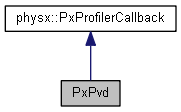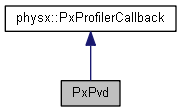PxPvd is the top-level class for the PVD framework, and the main customer interface for PVD configuration.It is a singleton class, instantiated and owned by the application.
More...
#include <PxPvd.h>
PxPvd is the top-level class for the PVD framework, and the main customer interface for PVD configuration.It is a singleton class, instantiated and owned by the application.
◆ ~PxPvd()
| virtual PxPvd::~PxPvd |
( |
| ) |
|
|
inlineprotectedvirtual |
◆ connect()
Connects the SDK to the PhysX Visual Debugger application.
- Parameters
-
| transport | transport for pvd captured data. |
| flags | Flags to set. return True if success |
◆ disconnect()
| virtual void PxPvd::disconnect |
( |
| ) |
|
|
pure virtual |
Disconnects the SDK from the PhysX Visual Debugger application. If we are still connected, this will kill the entire debugger connection.
◆ getInstrumentationFlags()
Retrieves the PVD flags. See PxPvdInstrumentationFlags.
◆ getTransport()
returns the PVD data transport returns NULL if no transport is present.
◆ isConnected()
| virtual bool PxPvd::isConnected |
( |
bool |
useCachedStatus = true | ) |
|
|
pure virtual |
Return if connection to PVD is created.
- Parameters
-
| useCachedStatus | 1> When useCachedStaus is false, isConnected() checks the lowlevel network status. This can be slow because it needs to lock the lowlevel network stream. If isConnected() is called frequently, the expense of locking can be significant. 2> When useCachedStatus is true, isConnected() checks the highlevel cached status with atomic access. It is faster than locking, but the status may be different from the lowlevel network with latency of up to one frame. The reason for this is that the cached status is changed inside socket listener, which is not called immediately when the lowlevel connection status changes. |
◆ release()
| virtual void PxPvd::release |
( |
| ) |
|
|
pure virtual |
Releases the pvd instance.
The documentation for this class was generated from the following file:




 Public Member Functions inherited from physx::PxProfilerCallback
Public Member Functions inherited from physx::PxProfilerCallback Protected Member Functions inherited from physx::PxProfilerCallback
Protected Member Functions inherited from physx::PxProfilerCallback